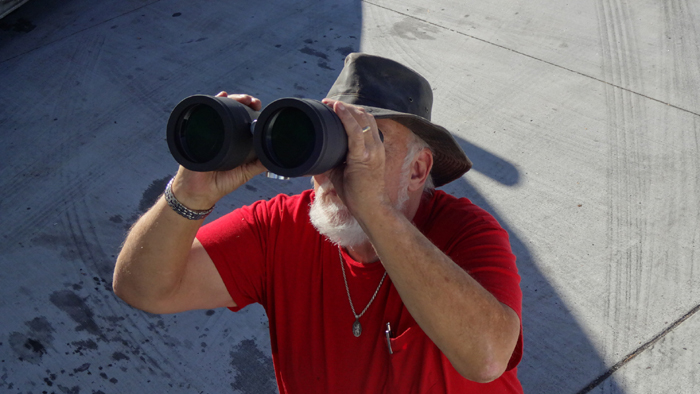
PERFORMANCE

I gotta hurry up and finish this project, I can't hold up
these big binoculars for much longer.
Performance review, maybe with a little video, will be posted here when
completed.
PERFORMANCE UPDATE -- March 2, 2019
I completed the construction of the Binocrane about a year ago. Since then I've
had opportunities to try it out from my suburban Denver back yard, the dark
skies of our astronomy club observing site 60 miles east of Denver, the Big Bend
National Park in Texas and the 2018 Okie-Tex Star (cloud?) Party. It got a lot
of attention at our astronomy club's public open house at Denver's historic
Chamberlin Observatory.
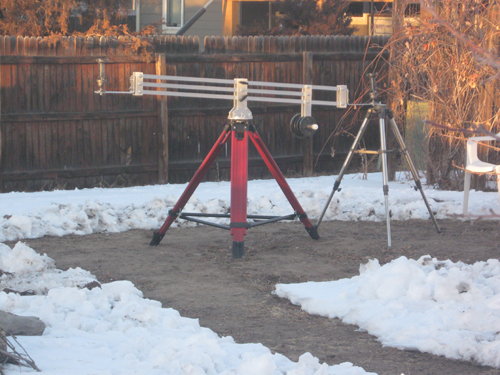
Backyard, Aurora Colorado

OkieTex Star Party, Kenton Oklahoma
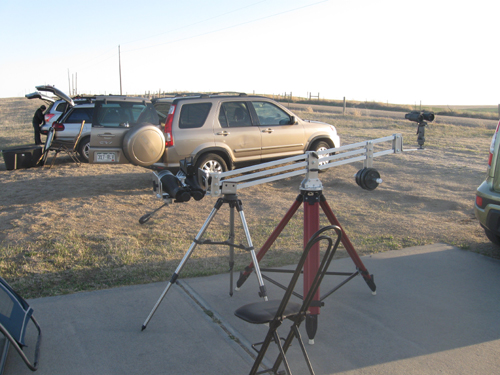
Edmund G. Kline Dark Sky Site, Deer Trail Colorado
Note the white rubber caps on the tripod feet.
These are hardware store items, replacement rubber caps for chair or stool feet.
The work great when setting up off the turf on a solid surface. They
protect the surface and prevent the tripod feet from sliding. The second
tripod is used to support the beam
while the binocular is attached.
The performance of the parallelogram mount met all of my expectations. The mount
is rock solid, with a settle down time of about one second. Even with the heavy
25x100 Orion, once zeroed in on an object you can take both hands off
the binoculars and they would stay locked on target. As the old saying
goes, "two eyes are better than one". I've always loved using binoculars
for terrestrial and astronomical viewing. A good solid binocular mount
really enhances the experience. Having hands free capability enables
activities such as sketching and consulting charts.
One feature of a parallelogram mount is that the binocular can be raised and
lowered without losing sight of the object you are viewing. This is a
great feature for outreach events. At the Denver Astronomical Society open
house I was able to share views of the young crescent Moon with adults and
children by simply raising or lowering the binoculars to the appropriate height.
Both the rotation and elevation of the mount are smooth as silk due to the PTFE
and nylon bearings. The tension is adjustable for both motions and can be fine
tuned for optimum performance.
Overall stability of the mount is great. As far as strength is concerned the
mount has no difficulty handling both a 25x100 and a 20x80 mounted on opposite
ends. With counterweights this is about a 40 pound load. I'm not about to
attempt destructive testing but I'd wager that the mount could easily support
twice that load.
The Dolica pistol grip mounts work great in conjunction with the mount. I've
used binos with these ball mounts with great success on tripods and monopods. I
fabricated a cradle mount for the 25x100's. It works after a fashion, but it's a
little awkward to maneuver at high elevations. It's also a bit bulky and quite
heavy. I'm considering a redesign and rebuild. The Dolica ball mounts will
support the big 100's, but you have to set the grip's adjustable tension to near
maximum. This makes pulling the trigger a two-handed procedure.
To this point I've only touched on the twin mount feature. Early in the design
process I decided to put a binocular on both ends of the parallelogram as
opposed to the traditional binocular on one end, counterweight on the other end.
I cannot claim that this is an original idea. I think I read a reference to the
idea in an online binocular forum, but in all of my image searches I've never
seen anything like it.
A remarkable feature of the twin mount is that it just takes a little shove on
the mount to swing the second pair of binoculars to right to you, so you can
change instruments without getting out of your chair. I can change binoculars
quicker than I can change eyepieces in my telescope. Here's a short video
clip demonstrating the swap with an older two beam version of the Binocrane:
I gave it more shove than needed, looks like I almost got knocked out of the
chair! (Note: This video was shot using the early twin beam version.)
DRAWBACKS -- Nothing is perfect!
--Weight: The tripod as modified weighs 16.8 pounds. The triple beam arm weighs
16.0 pounds and the big bino cradle 4.8 pounds for a total assembled weight of
37.6 pounds. Add 20 pounds of counterweights and you're over 50 pounds. Not the
kind of thing you'd want to pack up a hill, but the weight is a tradeoff for
increased stability.
-- Bulk: The beam is 62" in length, which can make it a bit tricky to load into
a car. I can get it into the back of my KIA Soul hatchback with the rear seats
folded down. I've had it packed in that car along with 4 pairs of binoculars, a
15" ultra compact Dobsonian telescope and all of my camping gear and still had
room for a passenger.
--Setup: Setup is a bit time consuming, just under thirty minutes, but
well worth it. The toughest part is assembling the cross braces to the tripod
legs, a cumbersome process. I'm considering putting a 4"x4" wood post in my back
yard with a RFP plate and bolt duplicating the top of the tripod. Having this
permanent pier would cut down on setup time at home
GALLERY -- Random pix that didn't make the cut for other content
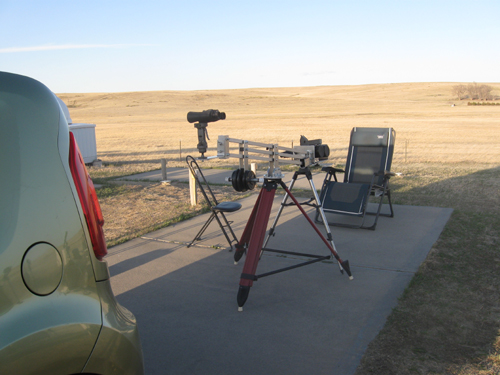
At Denver Astronomical Society-Edmund G. Kline
Dark Sky Site, Deer Trail Colorado
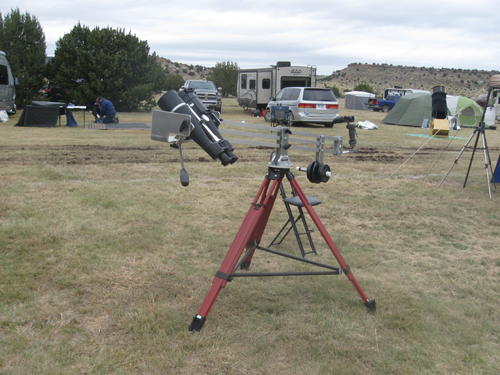
Okie-Tex Star Party, Kenton Oklahoma 2018
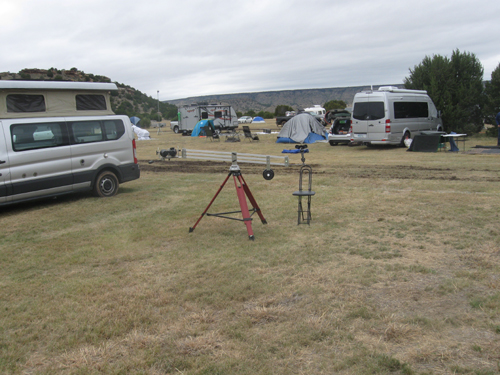
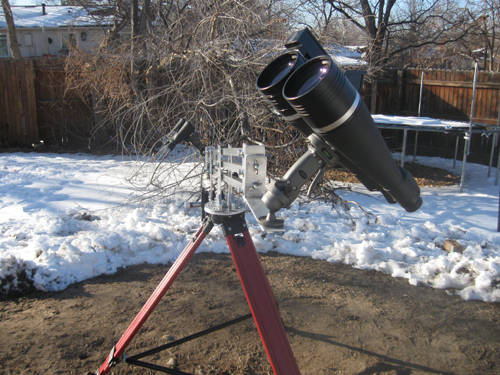
Back yard, Aurora Colorado
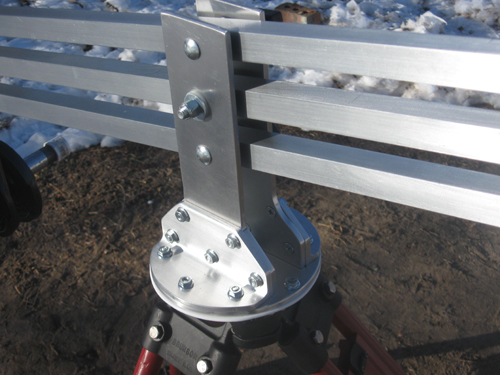
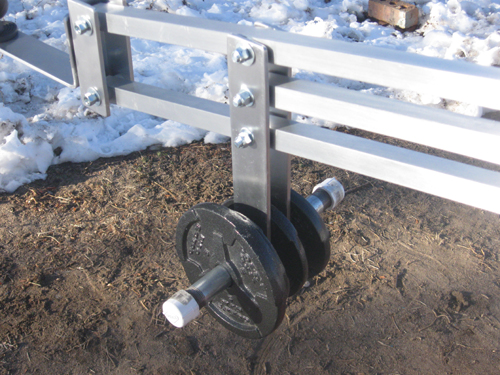
October 2019 Update
| My project was honored by being featured
in the October 2019 issue of Sky & Telescope Magazine. Astronomer's Workbench column by Jerry Oltion, pp. 70-71 |

